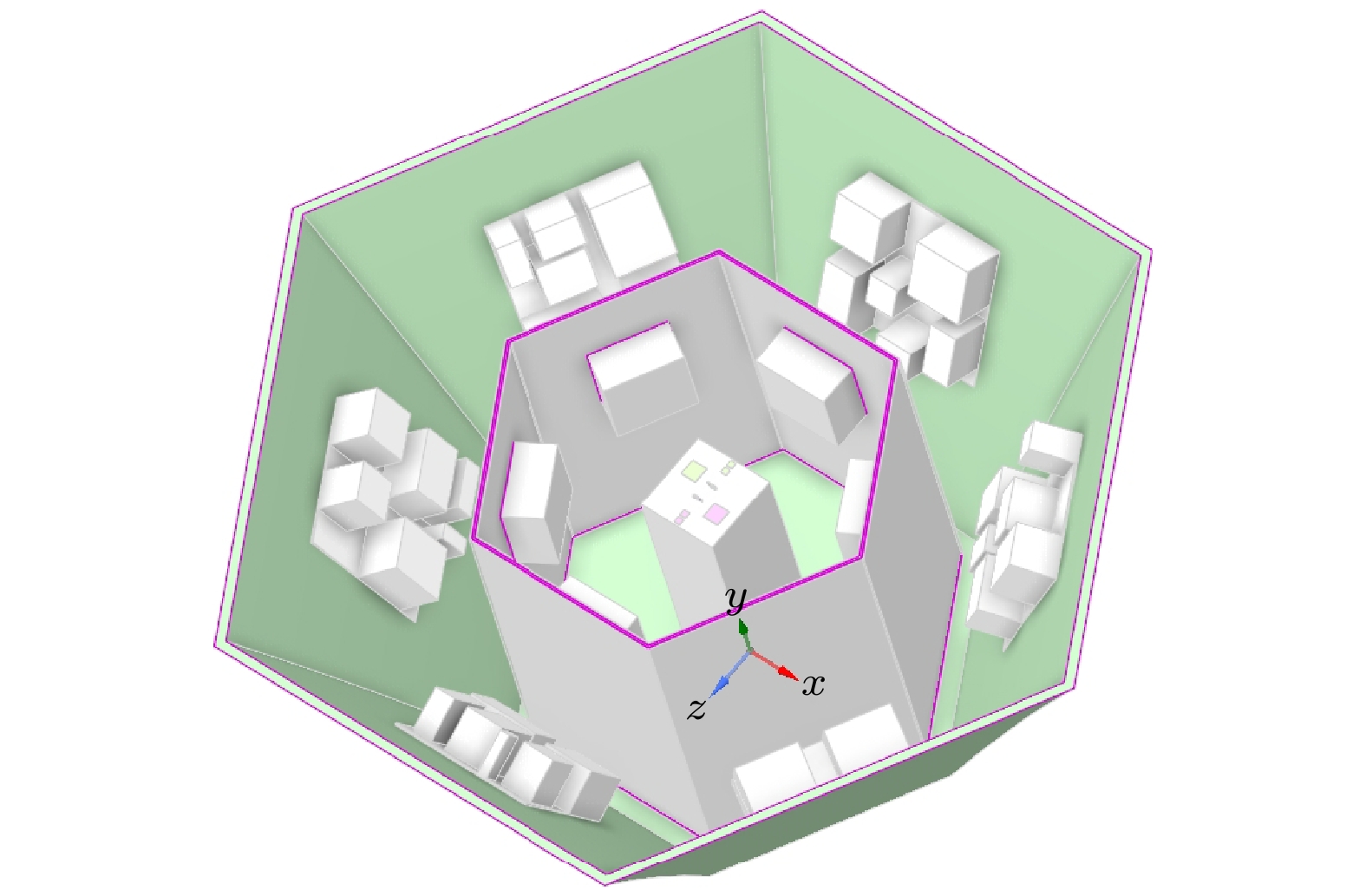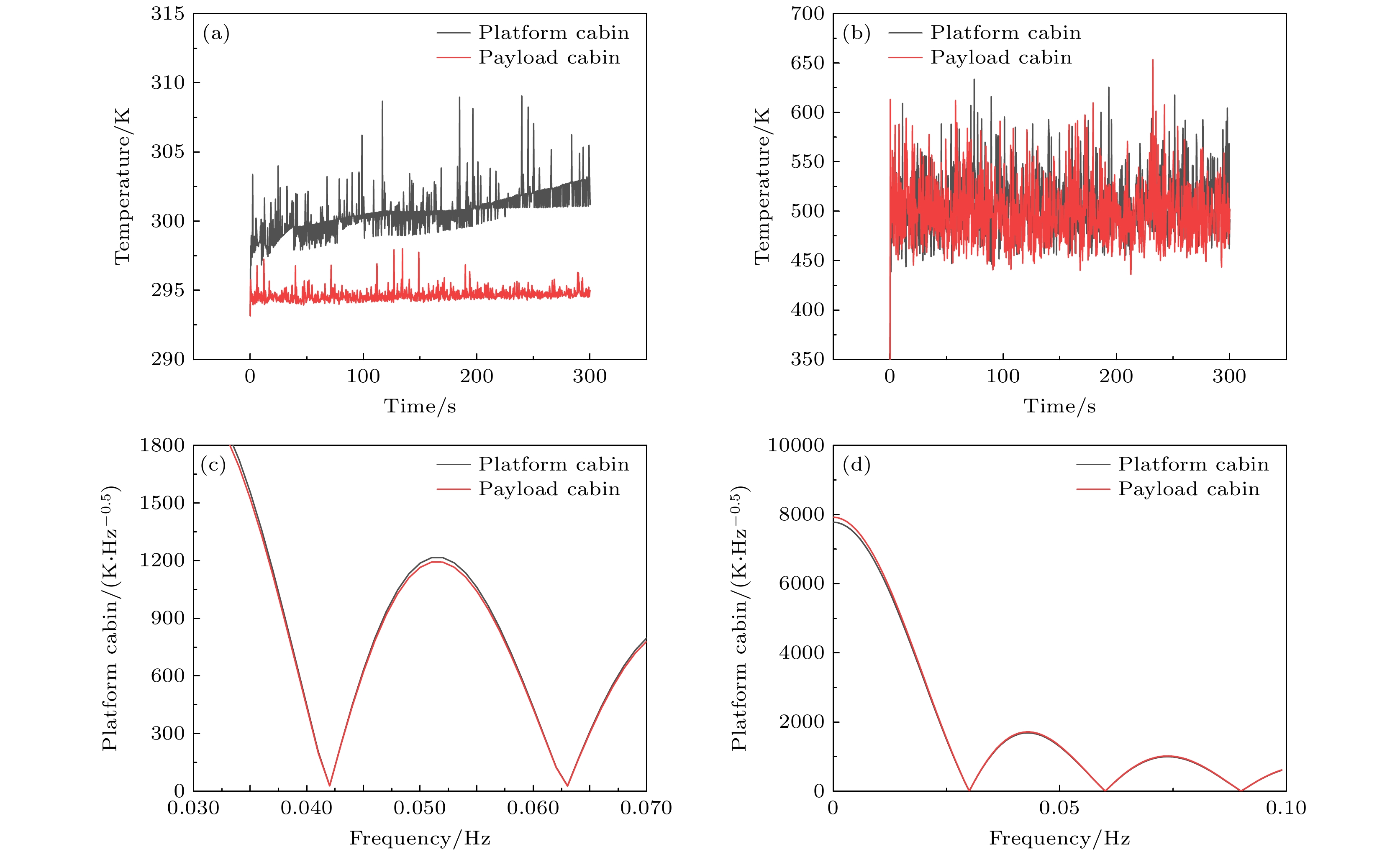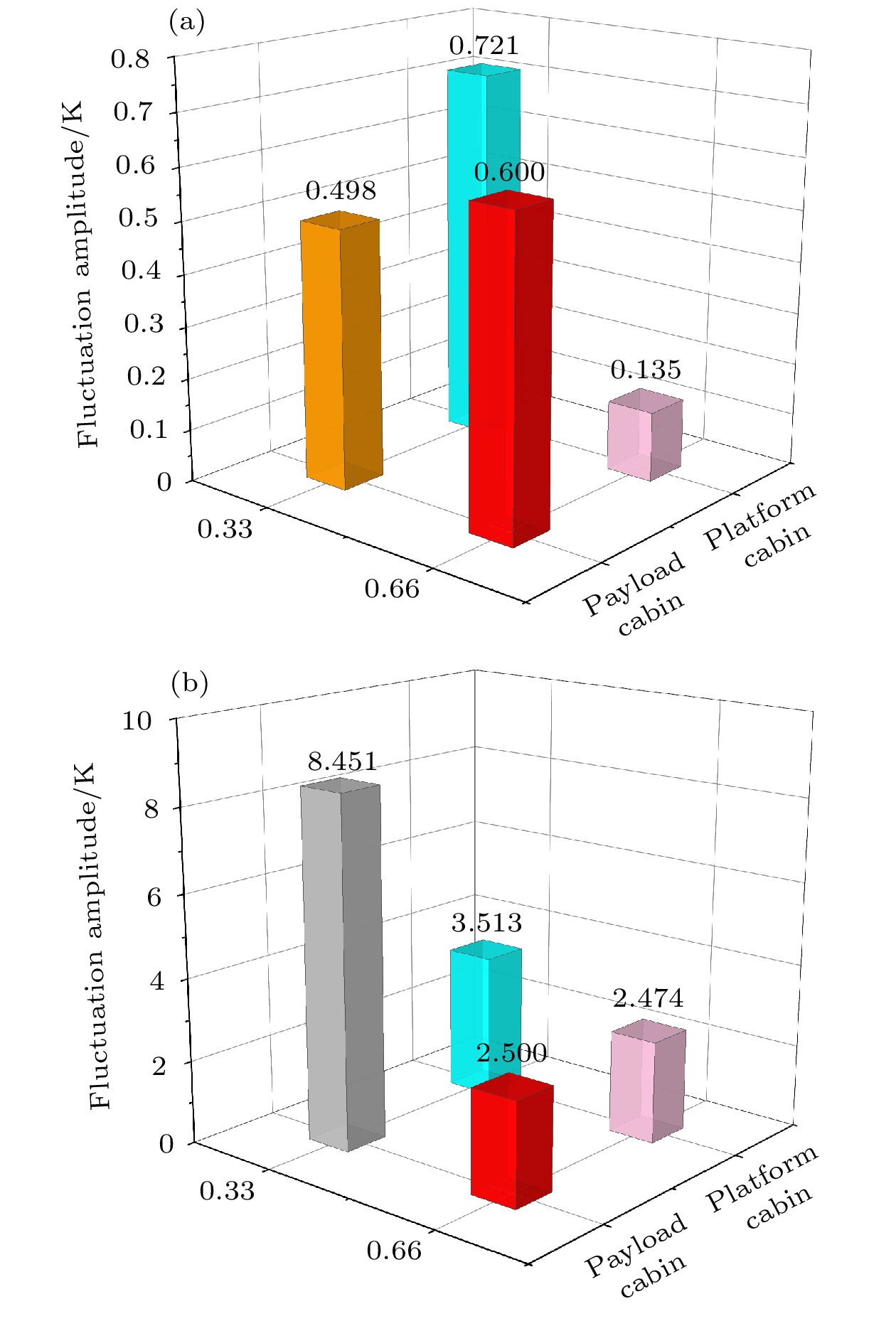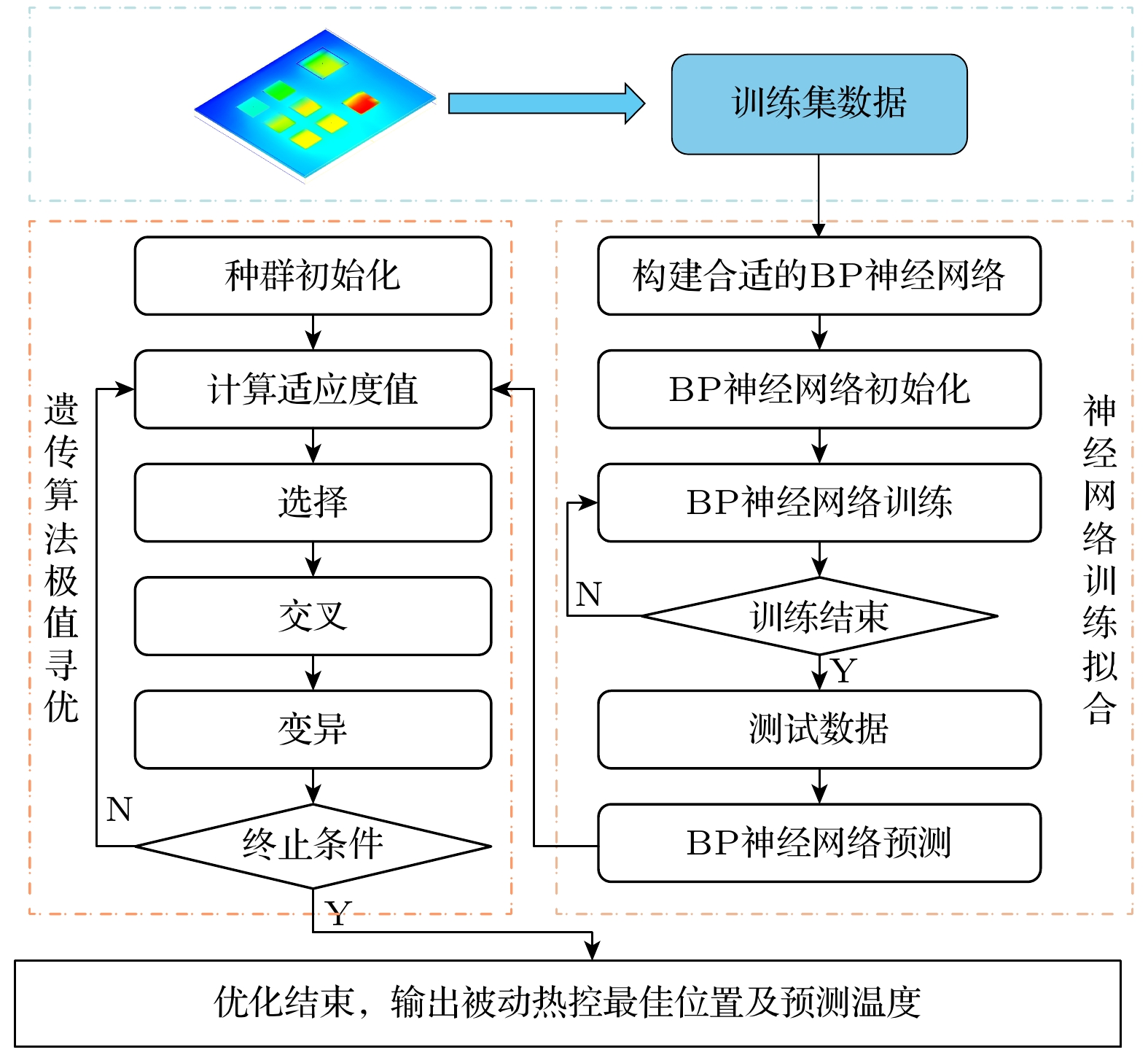-
为提高星载电子器件热分析的模拟分辨率和精度以及被动热控装置的控温效果, 本文建立系统多尺度模型获得不同尺度下卫星内部电子器件的温度场和热流信息. 结果表明: 系统多尺度模型在系统级尺度模拟精度与实际模型相对误差小于9%, 并且可消耗较少的计算资源获得器件级尺度芯片微小结构的热信息. 系统级模型可从宏观尺度评估星载被动热控材料的控温隔热性能, 采用复合相变隔热材料可将载荷舱室温度波动幅值降至2.43 K, 相比平台舱室温度波动幅值降低约69.43%, 通过复合相变隔热材料隔热后的温度波动信号呈现向高频域部分转移的特征. 基于多元回归分析选定需要进行重点隔热控温的舱室后, 采用器件级简化模型得到不同热控装置布局下的温度场信息形成训练数据集, 采用神经网络遗传算法在器件尺度预测被动热控装置的最佳安装位置, 并得到减小器件最大温度波动的热控布局方案, 最大温度波动降低2.74 K.
To improve the simulation resolution and accuracy in thermal analysis of spaceborne electronic devices and the temperature control performance of passive thermal control devices, a system multi-scale model is established, thereby obtaining the temperature field and heat flux of electronic devices inside the satellite on different scales as illustrated in the below figure. The temperature fluctuation mechanism inside the satellite is analyzed on different physical scales. The thermal analysis resolution of spaceborne electronic equipment is improved, and a method to reduce the power fluctuation of spaceborne equipment is proposed based on the results of system multi-scale thermal analysis. The results indicate that the accuracy deviation between the multi-scale model of the system and the actual model is less than 9%. However, the system multi-scale model saves 99.67% of the mesh generation time, which greatly improves the computation efficiency. The system multi-scale model can capture the thermal information about device-level chip microstructures at a lower computational cost. The system-level model can evaluate the temperature control and insulation performance of passive thermal control materials on a macroscale. The temperature fluctuation amplitude of the platform compartment is 7.95 K, while the temperature fluctuation amplitude of the load compartment decreases to 2.43 K after the temperature of the composite phase change insulation material has been controlled, which is 69.43% lower than that of the platform compartment. Compared with traditional vacuum insulation panels, the composite phase change materials are very superior in controlling the temperature of the chamber and suppressing temperature fluctuations. The temperature fluctuation signal after being insulated by the composite phase change insulation materials shows a characteristic of shifting to the high-frequency domain. After selecting the cabins that require key insulation and temperature control through multiple regression analysis, a simplified model at device level is employed to obtain temperature fields under different thermal control device layouts as a training dataset. A neural network genetic algorithm is used to predict the optimal installation position of passive thermal control device on the device scale and a thermal control layout scheme is obtained, which reduces the maximum temperature fluctuation of the device by 2.74 K. If the temperature uniformity coefficient is taken as the optimization goal, the temperature of each device on PCB board can be reduced to 14.39% of the average temperature of all devices through optimizations. -
Keywords:
- spaceborne electronic device /
- system multi-scale /
- temperature control /
- neural network genetic algorithm
[1] 张嘉麟, 李运泽, 赵欣, 周宇鹏, 魏然 2023 航天器工程 32 53
 Google Scholar
Google Scholar
Zhang J L, Li Y Z, Zhao X, Zhou Y P, Wei R 2023 S/C. E. 32 53
 Google Scholar
Google Scholar
[2] 王定标, 李昂, 吴淇涛, 张浩然, 王晓亮, 王光辉 2023 低温与超导 51 37
 Google Scholar
Google Scholar
Wang D B, Li A, Wu Q T, Zhang H R, Wang X L, Wang G H 2023 Cryog. Supercond. 51 37
 Google Scholar
Google Scholar
[3] 吴利明 2023 硕士学位论文(西安: 长安大学)
Wu L M 2023 M. S. Thesis (Xi’an: Chang’an University
[4] 冯建朝, 张晓峰, 梁鸿, 侍行剑, 何涛, 蔡志鸣 2023 宇航学报 44 132
 Google Scholar
Google Scholar
Feng J C, Zhang X F, Liang H, Shi X J, He T, Cai Z M 2023 J. Astronaut. 44 132
 Google Scholar
Google Scholar
[5] Mermer E, Ünal R 2023 J Braz. Soc. Mech. Sci. Eng. 45 160.
 Google Scholar
Google Scholar
[6] 胡越欣, 张立华, 高永, 魏然, 谭定银, 段会宗, 王丽娇 2022 航天器工程 31 1
 Google Scholar
Google Scholar
Hu Y X, Zhang L H, Gao Y, Wei R, Tan D Y, Duan H Z, Wang L J 2022 S/C. E. 31 1
 Google Scholar
Google Scholar
[7] 陈黎 2017 博士学位论文(西安: 西安交通大学)
Chen L 2017 Ph. D. Dissertation (Xi’an: Xi’an Jiaotong University
[8] 陶文铨 2009 传热与流动问题的多尺度数值模拟: 方法与应用(北京: 科学出版社) 第441页
Tao W Q 2009 Multiscale Numerical Simulation of Heat Transfer and Flow Problems: Methods and Applications (Beijing: China Science Publishing) p441
[9] 丁学凯, 孙立军 2022 ANSYS Icepak 2020 电子散热从入门到精通 (案例实战版) (北京: 电子工业出版社) 第25页
Ding X K, Sun L J 2022 ANSYS Icepak 2020 Electronics Cooling: From Beginner to Master (Case Study) (Beijing: Publishing House of Electronics Industry) p25
[10] 杨世铭, 陶文铨 2006 传热学(第五版) (北京: 高等教育出版社) 第62页
Yang S M, Tao W Q 2006 Heat transfer (5th Ed.) (Beijing: Higher Education Press) p62
[11] 刘红, 张晓峰, 冯建朝, 诸成, 蔡志鸣, 徐雨 2021 空间科学学报 41 337
 Google Scholar
Google Scholar
Liu H, Zhang X F, Feng J C, Zhu C, Cai Z M, Xu Y 2021 Chin. J. Space Sci. 41 337
 Google Scholar
Google Scholar
[12] 魏超 2012 博士学位论文(西安: 西安交通大学)
Wei C 2012 Ph. D. Dissertation (Xi’an: Xi’an Jiaotong University
[13] 赵欣 2008 航天器工程 17 57
 Google Scholar
Google Scholar
Zhao X 2008 S/C. E. 17 57
 Google Scholar
Google Scholar
[14] Wang Z H, He C B, Hu Y, Tang G H 2024 Sci. China: Technol. Sci. 67 2387
 Google Scholar
Google Scholar
[15] 胡和敏, 杜小泽, 杨立军, 杨勇平 2014 动力工程学报 34 216
Hu H M, Du X Z, Yang L J, Yang Y P 2014 J. Chi. Soc. P E. 34 216
[16] Shao X, Han H, Wang H, Ma J, Hu Y, Li C, Teng H, Chang G, Wang B, Wei Z 2023 Opt. Express 31 32813
 Google Scholar
Google Scholar
[17] 同济大学数学系 2017 概率论与数理统计(第四版)(北京: 人民邮电出版社) 第252页
Tongji University Department of Mathematics 2017 Probability Theory and Mathematical Statistics (Fourth Edition) (Beijing: Posts & Telecommunications Press) p252
[18] 程梅苏 2016 硕士学位论文(南京: 南京航空航天大学)
Cheng M S 2016 M. S. Thesis (Nanjing: Nanjing University of Aeronautics and Astronautics
[19] 黄梦真, 朱虹, 刘乃安, 谢小冬, 马超, 张首蕤 2024 工程热物理学报 45 588
Huang M Z, Zhu H, Liu N A, Xie X D, Ma C, Zhang S R 2024 J. Eng. Thermophys. 45 588
[20] Cho J W, Lee Y J, Kim J H, Hu R, Lee E, Kim S K 2023 ACS Nano 17 10442.
 Google Scholar
Google Scholar
[21] 徐志明 2018 博士学位论文 (合肥: 中国科学技术大学)
Xu Z M 2018 Ph. D. Dissertation (Hefei: University of Science and Technology of China
[22] Zhu Z, Wang Z, Liu T, Luo X, Qiu C, Hu R 2023 Cell Rep. Phys. Sci. 4 101540.
 Google Scholar
Google Scholar
[23] 夏冰, 陈厚源, 汪一萍, 潘加键, 白伟钢, 常文博, 丁延卫 2021 中山大学学报 60 138
 Google Scholar
Google Scholar
Xia B, Chen H Y, Wang Y P, Pan J J, Bai W G, Chang W B, Ding Y W 2021 Acta Sci. Nat. Univ. Sunyatseni 60 138
 Google Scholar
Google Scholar
[24] 王永康 2015 ANSYS Icepak 电子散热基础教程(北京: 国防工业出版社) 第30页
Wang Y K 2015 ANSYS Icepak Electronics Cooling Fundamentals Tutorial (Beijing: National Defense Industry Press) p30
[25] 朱文博 2023 硕士学位论文(长春: 中国科学院长春光学精密机械与物理研究所)
Zhu W B 2023 M. S. Thesis (Changchun: Changchun Institute of Optics, Fine Mechanicsand Physics, Chinese Academy of Sciences
[26] 李运泽, 魏传锋, 袁领双, 王浚 2005 北京航空航天大学学报 60 372
 Google Scholar
Google Scholar
Li Y Z, Wei C F, Yuan L S, Wang J 2005 J. Beijing Univ. Aeronaut. Astronaut. 60 372
 Google Scholar
Google Scholar
[27] 余志豪 2022 硕士学位论文 (哈尔滨: 哈尔滨工业大学)
Yu Z H 2022 M. S. Thesis (Harbin: Harbin Institute of Technology
-
图 5 卫星不同舱室温度结果 (a) 复合相变材料方案时域响应; (b) 真空隔热板方案时域响应; (c) 复合相变材料方案频域响应; (d) 真空隔热板方案频域响应
Fig. 5. Temperature results of different satellite cabins: (a) Time domain response of composite phase change material scheme; (b) time domain response of vacuum insulation board scheme; (c) frequency domain response of composite phase change material scheme; (d) frequency domain response of vacuum insulation board scheme.
图 8 不同热控布局方案指标分布图 (a) 不同热控布局电路板最高温度波动; (b)不同热控布局电路板温度均匀系数
Fig. 8. Indicators for different thermal control layouts: (a) Maximum temperature fluctuation of the circuit board in different thermal control layouts; (b) temperature uniformity coefficient of circuit boards in different thermal control layouts.
表 1 主要发热元件功率参数
Table 1. Power parameters of main heating sources.
发热元件 元件尺寸/mm3 封装类型 发热参数/W 芯片1 40×40×2 PQFP 0.5 芯片2—芯片7 26×26×2.15 PBGA 0.1 芯片8 30×30×1.25 QFP 0.3 表 2 不同建模方法结果的精度对比
Table 2. Accuracy comparison of results from different modeling methods.
评价指标 系统多尺度/℃ 全场密网格/℃ 相对误差/% 芯片1 103.133 99.722 3.307 芯片2 83.009 81.638 1.651 芯片3 83.058 81.683 1.655 芯片4 81.894 81.214 0.830 芯片5 82.021 80.524 1.825 芯片6 82.580 80.647 2.341 芯片7 81.596 80.230 1.674 芯片8 97.290 88.747 8.781 表 3 不同建模方法的网格统计信息
Table 3. Grid information of different modeling methods.
评价指标 系统多尺度 全场密网格 系统级 器件级 网格数量/个 10918 125316 10884559 最大网格尺寸/mm 12 1 12.5 最低面对齐率 0.61 0.05 网格生成时间/min <1 300 表 4 复合相变隔热材料热物性参数
Table 4. Thermophysical properties of composite phase change thermal insulation materials.
隔热层 密度
ρ/(kg·m–3)热导率 λ
/(W·m–1·K–1)比热容 cp
/(J·kg–1·K–1)相变材料1 900 2.95 2350 隔热材料 114 0.04 500 相变材料2 1500 12.53 2350 表 5 隔热舱室多元回归分析结果
Table 5. Multiple regression analysis results of insulated cabins.
平台舱室编号 显著性 共线性统计 1 4.8×10–5 4.797 2 0.757 1.066 3 0.118 1.039 4 4.47×10–12 1.035 5 4.18×10–4 5.245 6 0.014 4.685 -
[1] 张嘉麟, 李运泽, 赵欣, 周宇鹏, 魏然 2023 航天器工程 32 53
 Google Scholar
Google Scholar
Zhang J L, Li Y Z, Zhao X, Zhou Y P, Wei R 2023 S/C. E. 32 53
 Google Scholar
Google Scholar
[2] 王定标, 李昂, 吴淇涛, 张浩然, 王晓亮, 王光辉 2023 低温与超导 51 37
 Google Scholar
Google Scholar
Wang D B, Li A, Wu Q T, Zhang H R, Wang X L, Wang G H 2023 Cryog. Supercond. 51 37
 Google Scholar
Google Scholar
[3] 吴利明 2023 硕士学位论文(西安: 长安大学)
Wu L M 2023 M. S. Thesis (Xi’an: Chang’an University
[4] 冯建朝, 张晓峰, 梁鸿, 侍行剑, 何涛, 蔡志鸣 2023 宇航学报 44 132
 Google Scholar
Google Scholar
Feng J C, Zhang X F, Liang H, Shi X J, He T, Cai Z M 2023 J. Astronaut. 44 132
 Google Scholar
Google Scholar
[5] Mermer E, Ünal R 2023 J Braz. Soc. Mech. Sci. Eng. 45 160.
 Google Scholar
Google Scholar
[6] 胡越欣, 张立华, 高永, 魏然, 谭定银, 段会宗, 王丽娇 2022 航天器工程 31 1
 Google Scholar
Google Scholar
Hu Y X, Zhang L H, Gao Y, Wei R, Tan D Y, Duan H Z, Wang L J 2022 S/C. E. 31 1
 Google Scholar
Google Scholar
[7] 陈黎 2017 博士学位论文(西安: 西安交通大学)
Chen L 2017 Ph. D. Dissertation (Xi’an: Xi’an Jiaotong University
[8] 陶文铨 2009 传热与流动问题的多尺度数值模拟: 方法与应用(北京: 科学出版社) 第441页
Tao W Q 2009 Multiscale Numerical Simulation of Heat Transfer and Flow Problems: Methods and Applications (Beijing: China Science Publishing) p441
[9] 丁学凯, 孙立军 2022 ANSYS Icepak 2020 电子散热从入门到精通 (案例实战版) (北京: 电子工业出版社) 第25页
Ding X K, Sun L J 2022 ANSYS Icepak 2020 Electronics Cooling: From Beginner to Master (Case Study) (Beijing: Publishing House of Electronics Industry) p25
[10] 杨世铭, 陶文铨 2006 传热学(第五版) (北京: 高等教育出版社) 第62页
Yang S M, Tao W Q 2006 Heat transfer (5th Ed.) (Beijing: Higher Education Press) p62
[11] 刘红, 张晓峰, 冯建朝, 诸成, 蔡志鸣, 徐雨 2021 空间科学学报 41 337
 Google Scholar
Google Scholar
Liu H, Zhang X F, Feng J C, Zhu C, Cai Z M, Xu Y 2021 Chin. J. Space Sci. 41 337
 Google Scholar
Google Scholar
[12] 魏超 2012 博士学位论文(西安: 西安交通大学)
Wei C 2012 Ph. D. Dissertation (Xi’an: Xi’an Jiaotong University
[13] 赵欣 2008 航天器工程 17 57
 Google Scholar
Google Scholar
Zhao X 2008 S/C. E. 17 57
 Google Scholar
Google Scholar
[14] Wang Z H, He C B, Hu Y, Tang G H 2024 Sci. China: Technol. Sci. 67 2387
 Google Scholar
Google Scholar
[15] 胡和敏, 杜小泽, 杨立军, 杨勇平 2014 动力工程学报 34 216
Hu H M, Du X Z, Yang L J, Yang Y P 2014 J. Chi. Soc. P E. 34 216
[16] Shao X, Han H, Wang H, Ma J, Hu Y, Li C, Teng H, Chang G, Wang B, Wei Z 2023 Opt. Express 31 32813
 Google Scholar
Google Scholar
[17] 同济大学数学系 2017 概率论与数理统计(第四版)(北京: 人民邮电出版社) 第252页
Tongji University Department of Mathematics 2017 Probability Theory and Mathematical Statistics (Fourth Edition) (Beijing: Posts & Telecommunications Press) p252
[18] 程梅苏 2016 硕士学位论文(南京: 南京航空航天大学)
Cheng M S 2016 M. S. Thesis (Nanjing: Nanjing University of Aeronautics and Astronautics
[19] 黄梦真, 朱虹, 刘乃安, 谢小冬, 马超, 张首蕤 2024 工程热物理学报 45 588
Huang M Z, Zhu H, Liu N A, Xie X D, Ma C, Zhang S R 2024 J. Eng. Thermophys. 45 588
[20] Cho J W, Lee Y J, Kim J H, Hu R, Lee E, Kim S K 2023 ACS Nano 17 10442.
 Google Scholar
Google Scholar
[21] 徐志明 2018 博士学位论文 (合肥: 中国科学技术大学)
Xu Z M 2018 Ph. D. Dissertation (Hefei: University of Science and Technology of China
[22] Zhu Z, Wang Z, Liu T, Luo X, Qiu C, Hu R 2023 Cell Rep. Phys. Sci. 4 101540.
 Google Scholar
Google Scholar
[23] 夏冰, 陈厚源, 汪一萍, 潘加键, 白伟钢, 常文博, 丁延卫 2021 中山大学学报 60 138
 Google Scholar
Google Scholar
Xia B, Chen H Y, Wang Y P, Pan J J, Bai W G, Chang W B, Ding Y W 2021 Acta Sci. Nat. Univ. Sunyatseni 60 138
 Google Scholar
Google Scholar
[24] 王永康 2015 ANSYS Icepak 电子散热基础教程(北京: 国防工业出版社) 第30页
Wang Y K 2015 ANSYS Icepak Electronics Cooling Fundamentals Tutorial (Beijing: National Defense Industry Press) p30
[25] 朱文博 2023 硕士学位论文(长春: 中国科学院长春光学精密机械与物理研究所)
Zhu W B 2023 M. S. Thesis (Changchun: Changchun Institute of Optics, Fine Mechanicsand Physics, Chinese Academy of Sciences
[26] 李运泽, 魏传锋, 袁领双, 王浚 2005 北京航空航天大学学报 60 372
 Google Scholar
Google Scholar
Li Y Z, Wei C F, Yuan L S, Wang J 2005 J. Beijing Univ. Aeronaut. Astronaut. 60 372
 Google Scholar
Google Scholar
[27] 余志豪 2022 硕士学位论文 (哈尔滨: 哈尔滨工业大学)
Yu Z H 2022 M. S. Thesis (Harbin: Harbin Institute of Technology
计量
- 文章访问数: 4539
- PDF下载量: 75
- 被引次数: 0













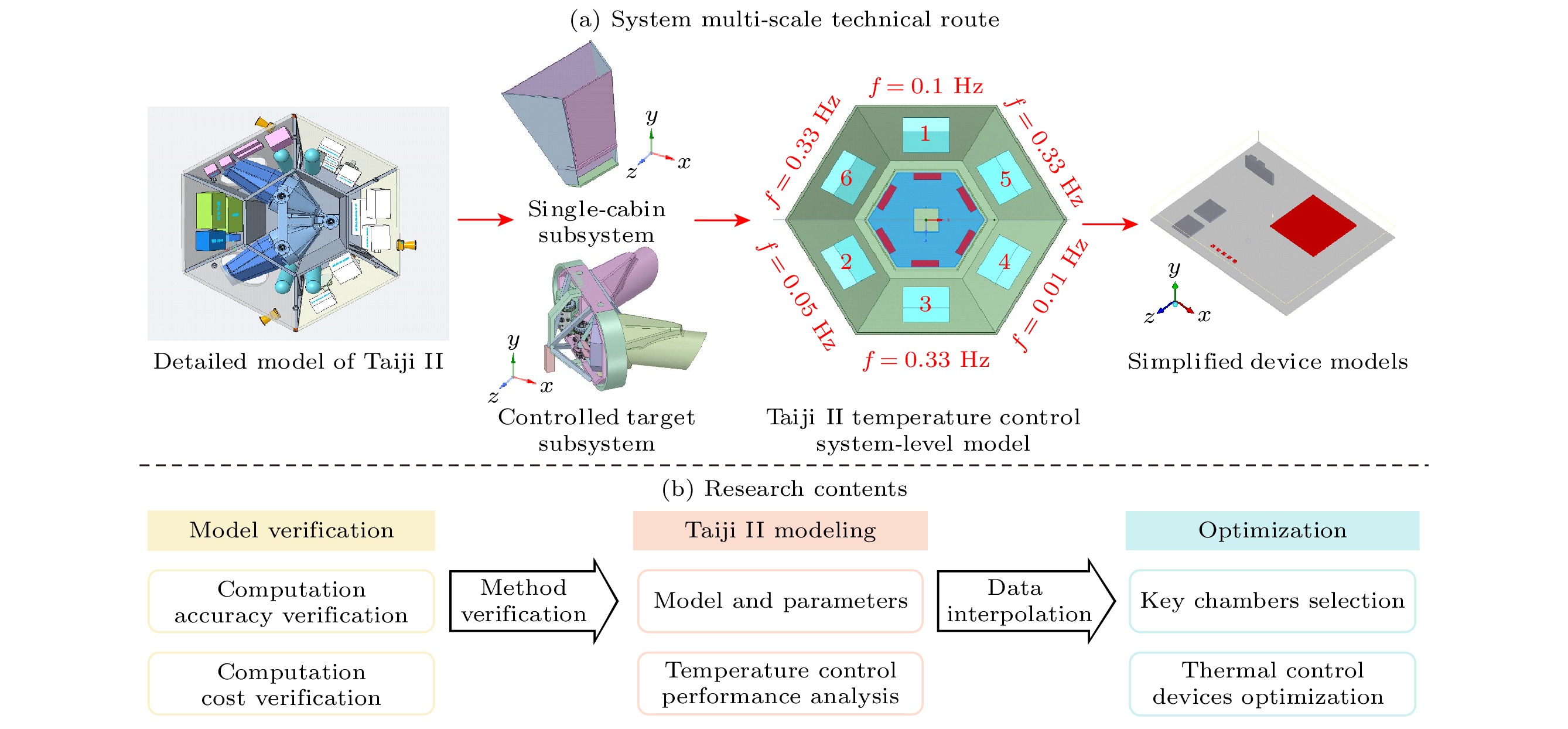
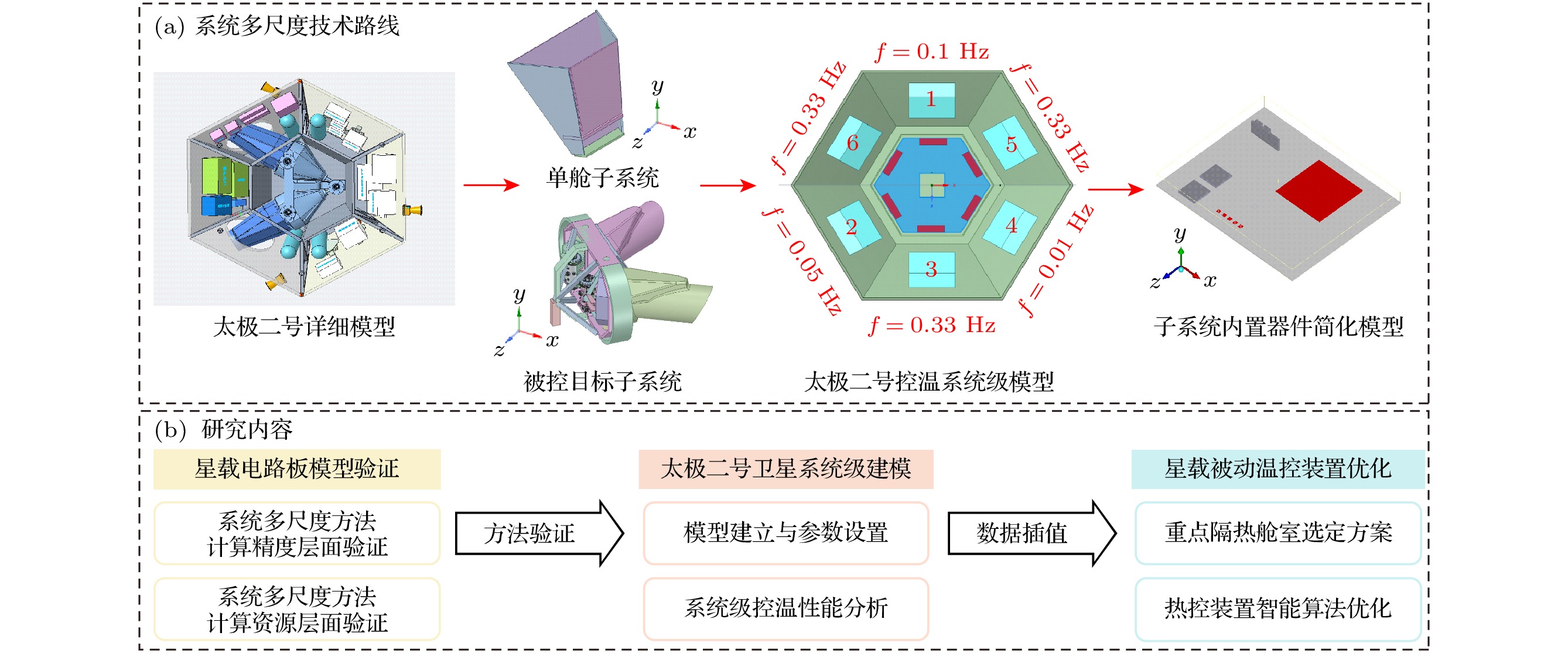
 下载:
下载:


